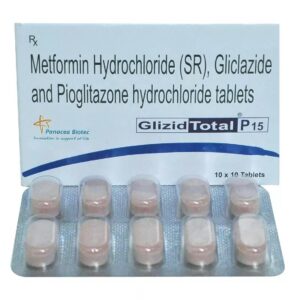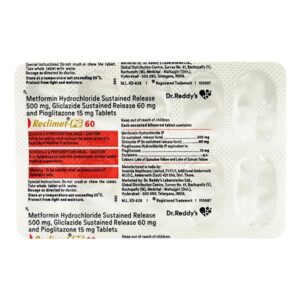METFORMIN + PIOGLITAZONE + GLICLAZIDE
Metformin: Metformin is a commonly prescribed medication for the treatment of type 2 diabetes. It belongs to a class of drugs called biguanides.
Metformin is primarily used to lower blood sugar levels in people with type 2 diabetes. It helps to improve insulin sensitivity and reduce glucose production in the liver. It also increases the uptake of glucose from the blood into the muscles, thereby lowering blood sugar levels.
Metformin is usually taken orally as tablets or extended-release tablets. The usual starting dose for adults is 500 mg or 850 mg once daily, with meals. The dose can be gradually increased based on the response to treatment, up to a maximum dose of 2,000 mg per day. The extended-release formulation is usually taken once daily with the evening meal.
Some common side effects of metformin include gastrointestinal issues such as nausea, diarrhea, and abdominal discomfort. These side effects usually resolve on their own over time. In rare cases, metformin can cause a serious condition called lactic acidosis, which can be life-threatening. Symptoms of lactic acidosis include weakness, tiredness, muscle pain, trouble breathing, and stomach discomfort. It is important to seek immediate medical attention if any of these symptoms occur.
It is worth noting that metformin may interact with certain medications, so it is important to inform your healthcare provider about all the medications you are taking before starting metformin.
Overall, metformin is an effective and widely used medication for the management of type 2 diabetes. It helps to control blood sugar levels and improve insulin sensitivity, but it can also cause some gastrointestinal side effects. Close monitoring by a healthcare provider is important to ensure the safe and effective use of metformin.
Pioglitazone: Pioglitazone is a medication used to treat type 2 diabetes mellitus. It belongs to a class of drugs known as thiazolidinediones, which help to improve insulin sensitivity and regulate blood sugar levels.
The mechanism of action of pioglitazone involves activation of peroxisome proliferator-activated receptor-gamma (PPAR-gamma) in the cells. This receptor is involved in the regulation of glucose and lipid metabolism. Pioglitazone enhances insulin sensitivity in the liver, muscle, and adipose tissues, leading to improved glucose utilization and reduced production of glucose by the liver.
The usual starting dose of pioglitazone is 15-30 mg per day, taken orally, with or without food. The dosage can be increased by 15 mg increments every few weeks to a maximum of 45 mg per day if necessary.
Common side effects of pioglitazone include weight gain, edema (fluid retention), headache, muscle pain, and upper respiratory tract infection. Some individuals may experience an increased risk of heart failure, especially if they already have heart problems or are at risk for heart disease. Therefore, it is important to use pioglitazone cautiously in patients with a history of heart failure.
Pioglitazone may also cause liver problems, so regular liver function tests are recommended during treatment. There have been rare reports of cases of serious liver injury with this medication.
It’s important to note that pioglitazone may increase the risk of bladder cancer, especially with long-term use or at higher doses. Therefore, patients should be aware of any symptoms such as blood in the urine or urgency in urination and report them to their healthcare provider.
Overall, pioglitazone is an effective medication for the management of type 2 diabetes, but it should always be used under the supervision of a healthcare professional to monitor for any potential side effects and interactions with other medications.
Gliclazide: Gliclazide is an oral medication that belongs to a class of drugs called sulfonylureas. It is primarily prescribed to control blood sugar levels in individuals with type 2 diabetes.
This medication works by stimulating the pancreas to produce more insulin, which helps to lower blood sugar levels. It also improves the sensitivity of body tissues to the effects of insulin, allowing glucose to be more efficiently absorbed by cells.
The dosage of Gliclazide varies depending on the individual’s condition and response to treatment. Generally, the starting dose is 80 mg per day, taken with breakfast or the first main meal. The dose may then be increased up to a maximum of 320 mg per day, if necessary.
Like any medication, Gliclazide may cause side effects. Common side effects include hypoglycemia (low blood sugar), which can cause symptoms such as dizziness, confusion, shakiness, and sweating. Other possible side effects include weight gain, gastrointestinal disturbances (such as nausea, vomiting, and diarrhea), skin reactions such as rash or itching, and mild changes in liver function. It is important to be aware of the signs of hypoglycemia and to treat it promptly by consuming a source of glucose (such as sugar or candy) if it occurs.
Gliclazide may also interact with other medications, so it is essential to inform your healthcare provider about all the medications you are taking before starting treatment. Additionally, it is important to follow a healthy diet and exercise regularly while taking Gliclazide to maximize its effectiveness in controlling blood sugar levels. Regular monitoring of blood sugar levels and periodic checks of kidney and liver functions are usually recommended during treatment with Gliclazide.


